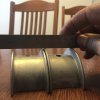2cubs2cases
Bigger Hammer
I second that and some lock tight.Carter, if those are bolts that backed out of the bearing retainer, how about using drilled bolts next time with safety wire?
I second that and some lock tight.Carter, if those are bolts that backed out of the bearing retainer, how about using drilled bolts next time with safety wire?
Found a serious problem.I had the chance to pull the transmission after work this evening, and it told a tale.
My method for pulling the T90 is to replace the top right and lower left bolts with long ones. I then remove the other two and slide the transmission back on the long bolts to clear the pilot bushing cleanly. (I use the same technique going back in.)
Anyway, the tale the transmission told is best shown with a picture.
View attachment 77671
Yes, the front bearing retainer is very loose, the bolts having worked their way out a considerable distance, and I believe I know the cause (my fault, of course), but that will have to wait till I’ve had a chance to inspect it more closely. You can also see where the retainer and the throw out bearing were rubbing as the retainer moved.
Meanwhile, after seeing that, I was very glad my son and I turned back when we did and made it home OK from Central Nevada in that condition.
At his point in time if you are able. I would disassemble the entire transmission and check every part for defects as well as verify serviceability. Then reassemble with any new parts if needed, new bearings and new seals. Something that I have learned about seals. The original seals often were only single lip seals . However as time has gone on SKF for instance has updated the seal and has a double lip seal available for the same application. Sometimes the only way I have ever found the updated seals is to look in the SKF seal book and/or call SKF to verify. The other updates for seals is material from neoprene to Viton for instance. Viton is much better and longer lasting than neoprene in most applications. I learned this reading the seals available based on the original number.The loose front bearing support is a good amount of your problem. If the input shaft moves forward, or more commonly the mainshaft is a bit too far to the rear, the synchro rings will jump out of engagement with the little steel keepers and spin. Usually the steel keepers break off if the synchro moves too far out.
The end play with my current (worn) bearing is 23 thousandths. I can make up at least 18 thousandths of that with a new bearing of the proper size.Forgive me for not re-reading the whole string, but did you ever measure the actual end play before disassembly? The few thousandths your chasing in bearing differences may not make much of a difference, considering your statement that you could actually watch the crank moving fore and aft as the clutch was engaged/disengaged. Wishing you success...……….
The bearing width is a standard dimension ....so if you are reading the back and plan to use an "0.020" bearing it will not change that end play for you. I only say this because you are not saying you compared the old to the new width of the thrust bearingThe end play with my current (worn) bearing is 23 thousandths. I can make up at least 18 thousandths of that with a new bearing of the proper size.


That engine will live with end play but.........if I could get it close or under 0.10 Id be happy .Here you can see the difference in the heights of the main bearing thrust faces.
The first picture shows the Federal Mogul bearing on the left and the Mahle Clevite on the right. Both are for a 10-under crank.
View attachment 78104
The next one shows the old 20-under main, from the Kaiser block, on the right. It’s hair taller than the Clevite. Still don’t know what brand it was
View attachment 78105
After careful measurement of each of these the length of the Federal Mogul and the Clevite appear to be the same at about 1.629”. The other old bearing is 1.630.”
You’ll recall from the table posted above, the spec for a new bearing length (per TRW) is I.632”. I’d sure like to find one that meets that spec. It would bring my end play to within 5 thousandths, and spec is 3-6, if I recall correctly.
You're right, of course. Perhaps I wasn't being clear. My wish for height is to to provide more thrust face surface area that might help those faces wear better. You'll recall the bearing I'm replacing is a short one and has worn down on the thrust faces, creating all that end play.Hey Carter, I might be missing something here, but shouldn’t the crank end play be set by thickness of sides of that bearing as opposed to the height? I don’t understand how the height would change horizontal play of the crank. I know the machine shop that did my crank stated that they would check the polish of that section and ensure they didn’t remove too much.
https://www.permatex.com/products/g...makers/permatex-the-right-stuff-gasket-maker/Carter, my absolute favorite is Permatex, The Right Stuff.
